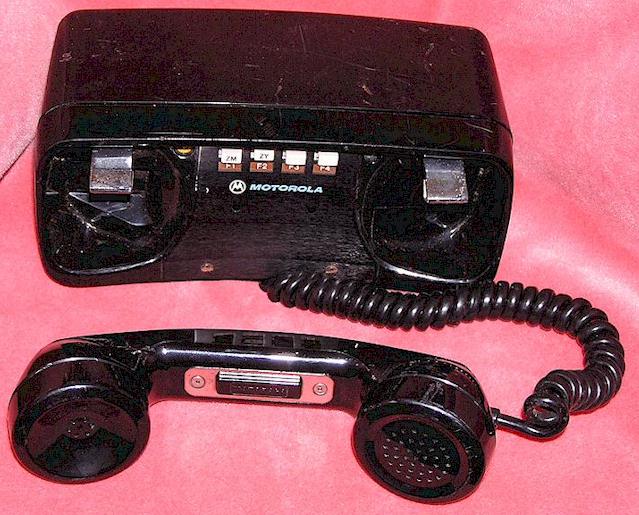
CHAPTER 6
MOTOROLA AND GE
MOBILE TELEPHONES
1970-1983
These years represent the most prolific period of conventional mobile telephone history. There were many different makes and models produced; what is shown below represents only some of the more popular equipment.
THE FINAL MTS EQUIPMENT
MTS equipment was still being made in the early 1970's to accommodate telephone companies which had not gone to IMTS or Dial systems yet (California would not do so until 1982 ! )
MOTOROLA'S LAST MTS EQUIPMENT
Motorola still manufactured MTS equipment well into the 1970's, but did so only to accommodate companies which were still using MTS systems, primarily those using the low band 35/43 MHz "Z" channels (which never went to IMTS.) These MTS radios were essentially traditional push-to-talk 2-way mobile radio chassis with an external decoder and a mobile telephone style control head. These telephones replaced the earlier "Motrac" and "Motran" radio packages which were sold with the "Manual" mobile telephone style head usually marketed with the TLD-1000 MTS radiotelephone.
Below is a photo of a Motorola head used by Pacific Telephone with a 35/43 MHz special production "Micor" radio, from 1974. Only two channels were installed, ZM and ZY. The other two pushbuttons were blocked from operating. This was the last product Motorola manufactured for manual mobile telephone use. It is believed that most of the subscribers on Pacific Telephone's Z Channel low band system by the 1970's were telephone company personnel. You can see that the head is actually an "MK" rotary dial head modified with a plate over the dial cutout, which blanks the dial area and provides the channel-change pushbuttons and lamps.

The control head above was used with the following 4-channel Micor radio drawers, although it is believed that the majority of those sold were low band 35/43 MHz equipment.
The Micor radio drawers were numbered as follows:
Q1358: 55W 35/43 MHz , Q1359: 60W 152/157 MHz , Q1379: 45W 450 MHz
The Q1358 was not duplexed - - presumably the other two were not either.
Motorola also marketed Q- prefixed Micor equipment with a duplexer as a UHF "Med System" ambulance radio, usually used in the "HEAR" hospital radio system.
GE's LAST MTS EQUIPMENT
GE, from about 1967 until the early 1970's, continued to offer an MTS car telephone which was essentially a MASTR Professional series mobile radio with an MTS tone decoder. The radio was called the "Simplex Radiotelephone" because the receiver was muted when the transmitter was on the air. In other words, the system was not duplex. These appear to have not been offered as a public MTS telephone on VHF high band channels but rather used by telephone company administrative personnel.
Shown below is the head for a low band GE MASTR Professional "simplex" MTS radiotelephone used by Pacific Telephone crews on the "Z" prefixed "Highway" channels in northern California in the 1970's. This head would have been provided by GE from about 1966-1971. Note the somewhat different panel layout than the head above, yet both were used with the same style radio. Note that unlike the "Dial" equipment, the pushbutton in the center of the channel select dial is decorative and non-functional. And in this case broken out!
MOTOROLA 1970's IMTS EQUIPMENT
PULSAR I:
In approximately 1971, Motorola introduced a new fully solid state VHF IMTS telephone called the "Pulsar," which replaced the 1963 vintage TLD-1100 and TLD-1220 "MJ" sets. The Pulsar was built in a housing which appears similar to the conventional Mocom 70 style radio, but otherwise shared none of the aspects of the Mocom 70. The Pulsar used plug-in circuit cards in a "cage" and modules for all functions except the transmitter power amplifier. The Pulsar supervisory card made first use of a proprietary thick film hybrid IC. The duplexer was combined with the receiver front end circuitry, and called a "Trisolector." The Pulsar would be retroactively called the "Pulsar I" when the "Pulsar II" was introduced.
The Pulsar was initially offered as a VHF radio only. In the late 1970's, the UHF Pulsar radio was introduced, however the radio package for that model is what is actually called the "Pulsar II" rather than being a UHF version of the Pulsar I drawer shown below.
The Pulsar was available with a variety of different control heads and options. It could be ordered to use the traditional control head of the earlier MJ sets, the "Pulsar" control head (a slightly smaller version of the MJ,) and the "FACTS" control head.
Later, it could be retrofitted to use the Pulsar II series control heads as well as the Pulsar 100 and 120 heads. The original Pulsar head did not offer interlocking "Roam" channel pushbuttons and was in that respect more cumbersome to use, at least in the aspect of a roamer trying to step through the various channels to find a marked idle tone. The "FACTS" control head deleted the "Roam" row of pushbuttons altogether and was essentially an IMTS control head designed for limited roaming through urban areas. It required a number of jumpers to be pre-programmed for the "Roam" list. The FACTS control head could also be used with the earlier "MJ" TLD-1100 series radios. See below.
The typical Pulsar I model was T1878A or T1878B. Pulsars suffered from a number of reliability issues; these included poor contact between the sockets and the plug-in circuit cards, and burned-open foil traces on the mother board because they were unable to reliably carry the 10-12 amps of current to the final amplifier section of the transmitter. Otherwise, the Pulsars were a design rather ahead of its time. Like the TLD-1100 "MJ" radios, the mobile subscriber's ID was programmed into the equipment by means of pin and jack connections on the supervisory printed circuit board. When the successor Pulsar II was introduced, the original Pulsar could be retrofitted with the "MACS" option, which allowed it to search for and seize a vacant channel when a call was attempted during an "all channels busy" situation. "MACS" stands for Motorola Automatic Channel Sentry. This was an important feature in the days when waiting for a free channel could be a lengthy process, and allowed its user to "jump" onto a vacant channel usually before others, whose recourse was only to endlessly bring the handset off-hook looking for the green light instead of the red busy light.
The typical Pulsar I original VHF head is shown below. The available colors were black and beige, and there were assorted wood-grain "appliqué" trim pieces which attached to the rear of the handset, marked with the logo of the phone company issuing the telephone. The unmarked switch on the far right would be the 12th channel in the UHF model. In the VHF model shown, it is unused.
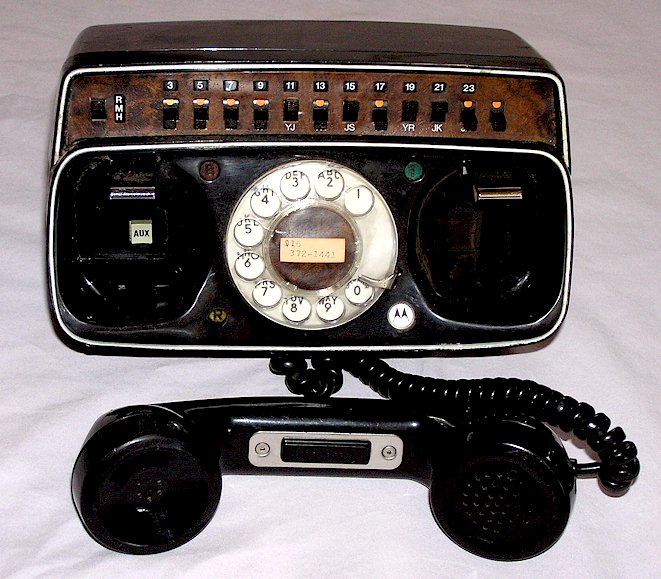
This is a UHF version of the Pulsar control head. Note the specialty printing on the back of the handset. From the pre-apocalypse days when Detroit was booming, and a real city.
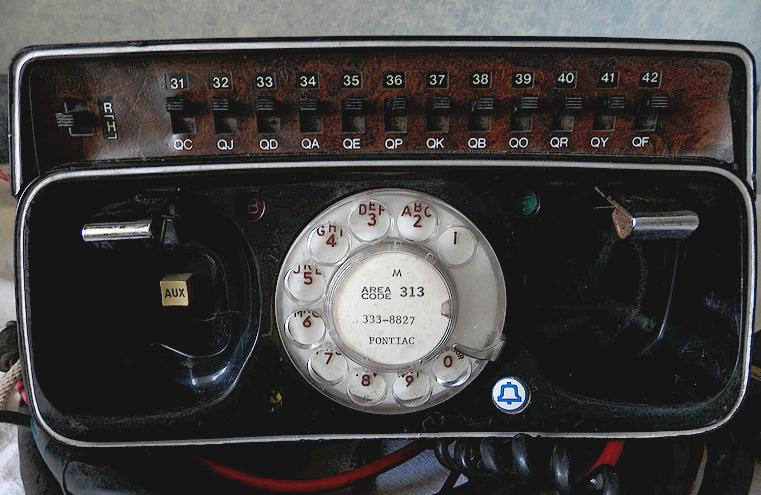
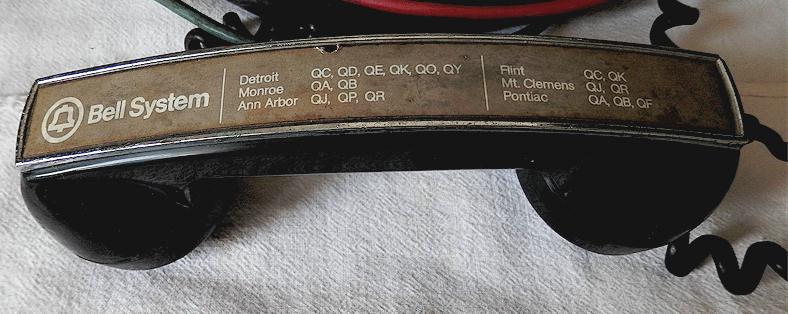
The standard first generation Pulsar radio drawers are shown below (later referred to as "Pulsar I.") A Western Electric marked Pulsar I on the left, and a Bell System marked Pulsar I on the right, with a MACS board installed above the Trisolector. Note that they look surprisingly similar to Motorola's Mocom 70 line of conventional radios, yet they share nothing in common. Even the housings do not interchange. Note that these were manufactured as VHF radios only.
FACTS:
FACTS was not actually a new model of car telephone but rather simply a streamlined control head, as mentioned above, without the manual mode channel selector buttons of previous heads. It actually slightly pre-dates 1974 and the FACTS heads can replace the standard MJ heads on all equipment (Pulsar sets required different interface boards for FACTS.) FACTS was initially sold for the TLD1220 series "MJ" and the T1414 UHF radios and later also used with Pulsar I and II equipment.
The FACTS control head has what looks like an LED channel indicator display, but it is really a matrix of small grain of wheat lamp bulbs in a metal mask assembly. One or two of these lamps are usually burned out, too. "FACTS" stood for Fully Automatic Car Telephone System. The FACTS head is very similar in operation to the MK head shown above, except that there is the illuminated channel display and provision for Manual, PTT style operation is retained. The "Away" position is essentially a "Roam" feature, however the "Away" channels have to be pre-selected via a set of internal jumpers and can not be changed by the user. The "Push to Step" button is used in the "Operator" or manual mode to advance through the channels manually. The FACTS heads were supplied in a number of colors, usually white, black and Bell Telephone green.
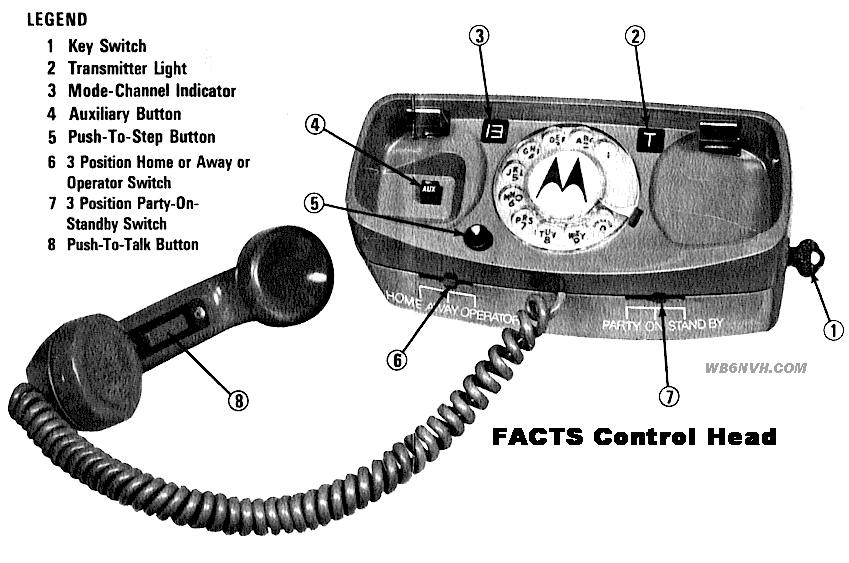
PULSAR II:
In approximately 1979, Motorola introduced the Pulsar II, their last IMTS platform. Interestingly, the Pulsar II radio is much larger than the Pulsar I, much heavier, and more cumbersome to service. The Pulsar II uses a unique heavy, cast one-piece housing which was not shared by any other Motorola product. Pulsar II's continued the design of plug-in cards for the circuitry, but they were not interchangeable with the cards of the Pulsar I. The Pulsar II cards use a different form of plastic connector, which may be more reliable than the open connector socket pins used on the Pulsar I cards.
The Pulsar II introduced some unique new features such as VSP (Vehicular Speaker Phone) and MACS (Motorola Automatic Channel Sentry, see above.) The MACS board was also available as a retrofit option for earlier Pulsar I drawers, and in those sets was placed on top of the Trisolector casting (again, see photo above.) . The Pulsar II was first sold as a UHF version of the Pulsar I, intended to replace the MK mobile radio, and sold with either a UHF marked Pulsar I control head or an MK control head, and shortly thereafter was changed to use the Pulsar II style head shown below. Then, a VHF version was produced, and Pulsar I production dropped altogether. This led to the early confusion of calling the Pulsar II the "UHF radio telephone" and the Pulsar I the "Pulsar radio telephone."
The housing is a solid, one-piece casting which lifts off by loosening the screw fasteners on the bottom side. Unlike the Pulsar I, the II was designed with the annoying feature of a mounting tray, adding weight, complexity and tears when the units are found on the used-equipment market without them.
The Pulsar II style control heads were sold in either black or off-white (now typically a faded, dirty yellow.) The head is connected by a flat ribbon cable to a plastic "junction box" which in turn mates to the standard mobile cable and has connections for the speaker-amplifier and certain other accessories. The Pulsar II radio drawers used the same connector as the Pulsar I, but require a unique and proprietary connector on the cable end as the II series requires a deeper "snout" on the connector body than the Pulsar I series does. The "Off Hook" switch allows dialing and listening with the handset still hung on the cradle/base assembly. Note that there is considerable circuitry in both the handset and the base cradle. The Pulsar II heads have a rudimentary memory capability and can store roaming channel sets and numbers.
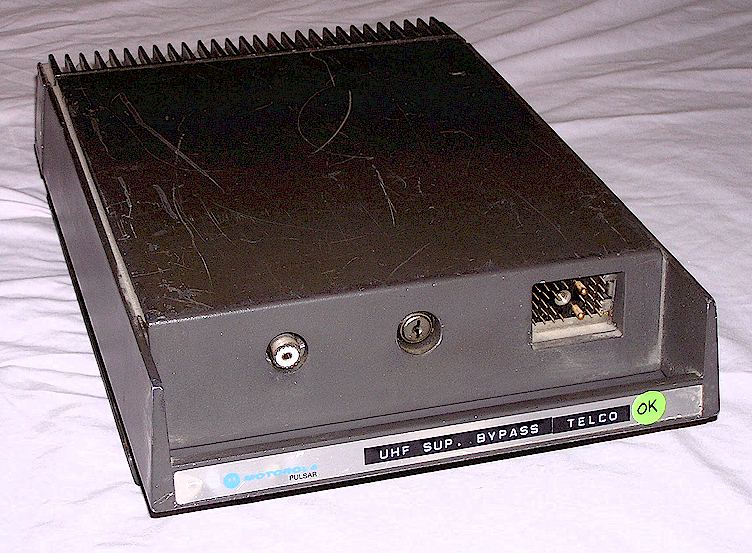
PULSAR 100 and PULSAR 120:
The Pulsar 100 and 120 are control heads only and not completely new radio systems. The Pulsar 100 and 120 control heads appear to have been cheaper alternatives to the Pulsar II control head and while sold during the Pulsar II production period could be retrofitted to the Pulsar I radio drawer via a new cable set. With mechanical manual channel switch selection and rotary dial (100) or pushbutton dial (120) these heads offered "no frills" operation with the basic Pulsar II chassis. They had no memory, no speaker phone and no digital displays. These heads were widely used by Bell operating companies such as Pacific Telephone. The escutcheons were available in either vertical or horizontal orientation to allow for mounting in various vehicle configurations. The vertical format was usually used in cars with a solid center console.
Note that the Pulsar 100 and 120 use the same radio drawer as the Pulsar II shown above, the only difference is the control unit interface circuit board card inside the drawer unit.
GE Mid-1970's IMTS Equipment
MASTR Executive II Mobile Telephones:
The GE MASTR Executive II mobile telephones were essentially a standard Executive II mobile radio with a duplexer (Phelps Dodge or Sinclair) mounted in a humped top cover section, and replaced the older CC56 series MASTR Professional series. They were also GE's last IMTS car telephone and available in either VHF or UHF. Unlike the previous CC56 MASTR series, supervisory signaling equipment was not located inside the drawer itself but was expected to be provided by the control head, obtained separately. There were two Exec II versions, a last generation synthesized version (prefixed CS56) and an older crystal control version (still prefixed CC56). Although there was an IMTS (Secode similar to VP-5 Series) control head offered by GE, most of these units seem to have been sold less accessories. The Secode heads as shown below were also available with a Touch-Tone® style keypad. I am not sure if these had an actual VP- Secode model number assigned to them. Many of these units in VHF were purchased by Pacific Telephone & Telegraph in California around 1982, and used with a Callmaster MT-300 series control head (shown elsewhere on these pages.) In other areas, these drawers were used with the Secode VP-5 control head labeled "GE." See photo below.
Ver. 8/18/2013 © 2007 Geoffrey C. Fors All rights reserved